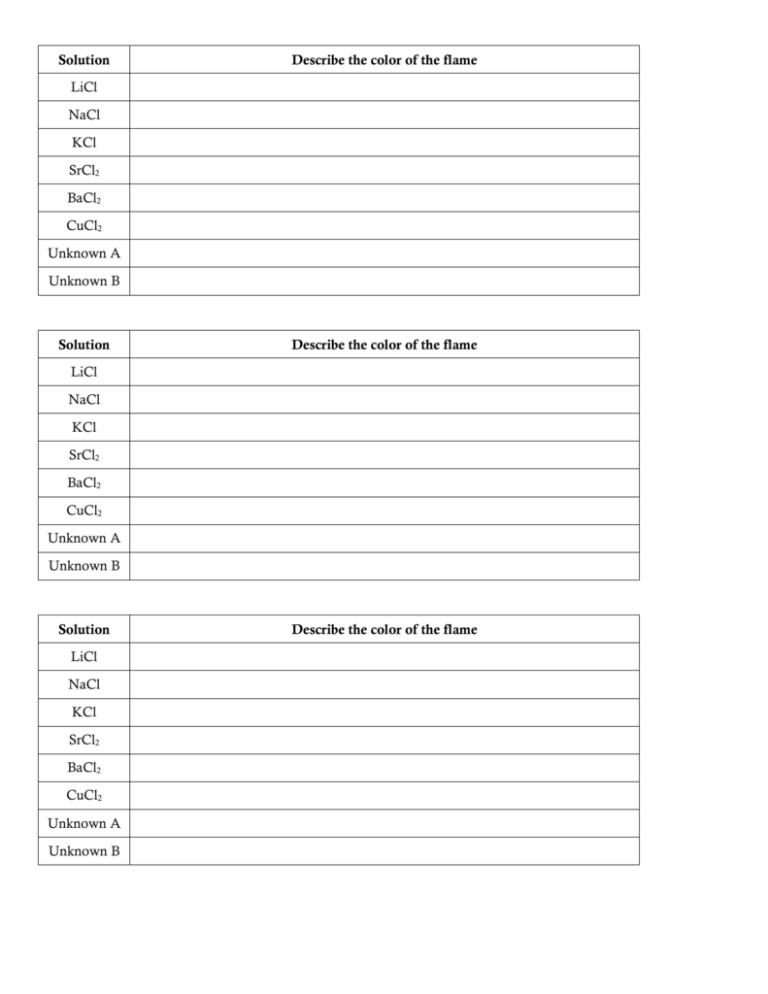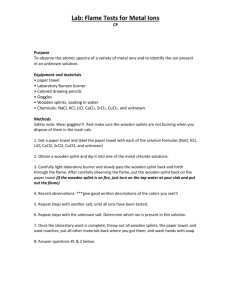Flame Test Lab
advertisement

Solution Describe the color of the flame LiCl NaCl KCl SrCl2 BaCl2 CuCl2 Unknown A Unknown B Solution Describe the color of the flame LiCl NaCl KCl SrCl2 BaCl2 CuCl2 Unknown A Unknown B Solution LiCl NaCl KCl SrCl2 BaCl2 CuCl2 Unknown A Unknown B Describe the color of the flame Flame Test Lab Conclusion Questions Answer in complete sentences on p. 52 (below your data chart) 1. Was your hypothesis supported? 2. Make a claim to answer your research question. Ex) “The effect of different elements on flame color is…” 3. Provide 2-3 pieces of evidence to support your claim. Ex) “For example, when I burned lithium (Li)…but when I burned barium (Ba)…” 4. Explain your reasoning. This means provide an explanation for this claim/evidence. Use scientific vocabulary and concepts from class in your answer! Ex) “This happens because…” 5. Identify two possible sources of error in your experiment. 6. Draw a diagram to show what is happening to an individual atom when we burn it like this. Your diagram should show three steps! 7. Reflect: Choose one of these options. a) Give two real-world situations where it might be useful to understand how different elements affect the color of a flame. b) Describe how the flame test lab is different from the emission spectra we looked at on paper in the article last week. Provide a possible explanation for why they are different. c) We didn’t create a graph in this lab. Explain why it might be difficult to make a graph to show your data. Is there a way you could have done it? Flame Test Lab Conclusion Questions Answer in complete sentences on p. 52 (below your data chart) 1. Was your hypothesis supported? 2. Make a claim to answer your research question. Ex) “The effect of different elements on flame color is…” 3. Provide 2-3 pieces of evidence to support your claim. Ex) “For example, when I burned lithium (Li)…but when I burned barium (Ba)…” 4. Explain your reasoning. This means provide an explanation for this claim/evidence. Use scientific vocabulary and concepts from class in your answer! Ex) “This happens because…” 5. Identify two possible sources of error in your experiment. 6. Draw a diagram to show what is happening to an individual atom when we burn it like this. Your diagram should show three steps! 7. Reflect: Choose one of these options. a) Give two real-world situations where it might be useful to understand how different elements affect the color of a flame. b) Describe how the flame test lab is different from the emission spectra we looked at on paper in the article last week. Provide a possible explanation for why they are different. c) We didn’t create a graph in this lab. Explain why it might be difficult to make a graph to show your data. Is there a way you could have done it? Flame Test Lab Pre-Lab Copy and complete on p. 51 Question: What is the effect of elements on flame color? Hypothesis: IF I burn solutions of different elements, THEN ___________________________ BECAUSE _______________________. Materials: 10 mL each of LiCl, NaCl, KCl, SrCl2, BaCl2, CuCl2, Unknown A, and Unknown B solutions 1 test tube for each solution 1 wooden splint for each solution, pre-soaked 1 Bunsen burner Procedures: 1. Remove a splint from a solution. 2. Hold the splint in a flame. Be careful not to catch it on fire! 3. Record the color of the flame. 4. Repeat for all solutions. Flame Test Lab Pre-Lab Copy and complete on p. 51 Question: What is the effect of elements on flame color? Hypothesis: IF I burn solutions of different elements, THEN ___________________________ BECAUSE _______________________. Materials: 10 mL each of LiCl, NaCl, KCl, SrCl2, BaCl2, CuCl2, Unknown A, and Unknown B solutions 1 test tube for each solution 1 wooden splint for each solution, pre-soaked 1 Bunsen burner Procedures: 1. Remove a splint from a solution. 2. Hold the splint in a flame. Be careful not to catch it on fire! 3. Record the color of the flame. 4. Repeat for all solutions.






